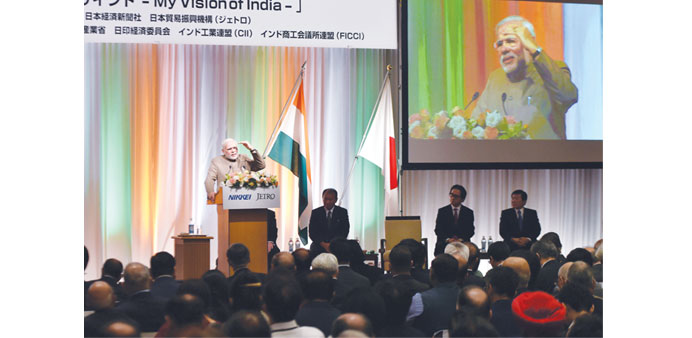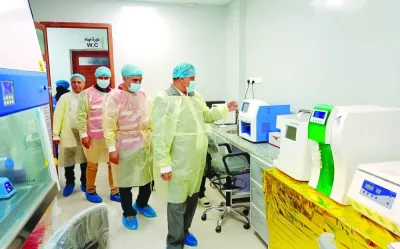Agencies/Tokyo
Prime Minister Narendra Modi yesterday sought to reassure investors that his reformist agenda would translate into better governance for Asia’s third-largest economy.
During an official visit to Japan, the Indian leader told business leaders in Tokyo that he wanted to cast off the image of a country shackled by red tape and poor infrastructure.
“We have carried out various deregulation measures,” Modi, who swept to power in May, told a forum hosted by the Nikkei newspaper and the Japan External Trade Organisation.
“Businesses and industries need stability and a growth environment. India has become a country that provides both.
“I’ve come to assure you there is no red tape but only red carpet that awaits you in India.”
The Japanese government is encouraging businesses to tap fast-growing emerging markets such as India, as the domestic market shrinks due to a rapidly ageing population and low birth rate.
Modi said India was also the only place where the Japanese industry will pleasantly find all the three ‘Ds” - democracy, demography and demand.
“I have come here to assure you that if you have to look anywhere outside Japan, you do not need to look here or there,” he said, adding: “We particularly want to encourage and invite small and medium enterprises, as also small-scale industries.”
Prime Minister Shinzo Abe, after holding an official meeting with Modi on Monday, announced his intention to offer public and private investment and financing worth ¥3.5tn ($34bn) over five years to pave the way for Japanese firms to boost their ties to the Indian market.
The figure, which marks a doubling of present levels, includes a ¥50bn yen loan for infrastructure development for a country where transport links, power production and telecommunications systems can be shaky and unreliable.
India’s new government has pledged to fix the flagging economy and provide water, power and toilets to every home.
Modi’s administration also said it was aiming to overhaul India’s dilapidated roads and build a high-speed train network and more airports.
But the experience of Japanese and other foreign firms in India has been marred by some high-profile disasters.
Among them was pharmaceutical maker Daiichi Sankyo’s $4.6bn purchase of Indian giant Ranbaxy in 2008.
The Japanese drugs maker decided to sell Ranbaxy in April after US regulators banned imports of its drugs over quality concerns, dealing a huge blow to Daiichi Sankyo’s bottom line.
Small car maker Suzuki has suffered from bouts of labour unrest at its Indian operations, including a 2012 riot that resulted in the death of a personnel manager.
But yesterday, Suzuki’s chief said the company had seen big financial success since it entered the Indian market three decades ago.
“Geographically, India is nine times larger than Japan. Its population is 10 times bigger,” Osamu Suzuki told the forum.
“This is a nation whose economy is bound to grow.”
Later in the day Modi met with Emperor Akihito.
The emperor and Empress Michiko had visited India last year, after Japan and India marked the 60th anniversary of diplomatic relations.
The emperor told Modi that they were impressed by Indian students’ fluency in Japanese at Jawaharlal Nehru University when they visited, the Kyodo news agency reported.

Prime Minister Narendra Modi delivers a speech u201cMy vision of Indiau201d in Tokyo yesterday.


